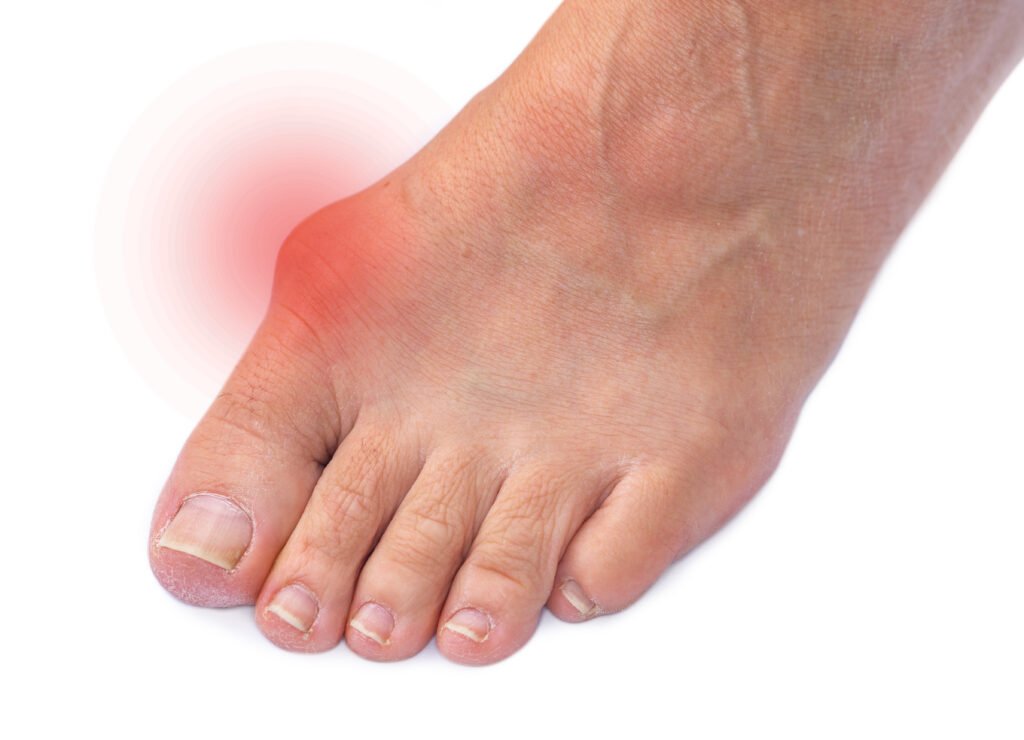Bunions
Prominent Big Toe Joint
 A bunion, also known as “Hallux abducto valgus” is a big toe joint deformity in which a bony protrusion forms and the big toe bends toward the lesser toes. The bony protrusion is often accompanied by a fluid filled sac called a bursa, which adds to the deformity. Bunions can cause persistent pain, swelling, and redness around the affected joint, particularly if it is being irriated by tight footwear. Individuals may also experience limited, painful movement of the big toe if arthritis is involved, making it difficult to perform everyday activities such as walking or wearing shoes comfortably. The discomfort can vary from mild to severe, often exacerbated by prolonged periods of standing or walking.
A bunion, also known as “Hallux abducto valgus” is a big toe joint deformity in which a bony protrusion forms and the big toe bends toward the lesser toes. The bony protrusion is often accompanied by a fluid filled sac called a bursa, which adds to the deformity. Bunions can cause persistent pain, swelling, and redness around the affected joint, particularly if it is being irriated by tight footwear. Individuals may also experience limited, painful movement of the big toe if arthritis is involved, making it difficult to perform everyday activities such as walking or wearing shoes comfortably. The discomfort can vary from mild to severe, often exacerbated by prolonged periods of standing or walking.
The development of a bunion is a gradual process. Initially, it starts as a mild deformity, but over time, it can become more pronounced the rate and severity of the deformity is different from person to person, and is graded on a scale of 1-4.
Early detection and intervention are crucial to managing the condition effectively. Seeking professional advice from a chiropodist at the initial signs of a bunion can help mitigate its progression and alleviate symptoms.
Risk Factors
- Genetic Predisposition – Those with a family history of bunions are more likely to develop them due to inherited foot structures, such as flat feet or excessively flexible ligaments.
- Foot Mechanics – Flat feet with a “hypermobile first ray” are at increased risk of developing a bunion.
- Improper Footwear – High heels and tight, pointed shoes, which force the toes into an unnatural position, can place excessive pressure on the big toe joint, leading to the development or worsening of bunions. Wearing shoes that do not provide adequate support or space for the toes can accelerate the misalignment of the joint.
- Underlying Conditions – Osteoarthritis and rheumatoid arthritis, can cause inflammation and damage to the joints, increasing the risk of bunion development. Neuromuscular conditions, such as cerebral palsy or multiple sclerosis, can also affect the muscles and nerves of the feet, contributing to the development of this deformity.
Treatment
Conservative treatment is first line. This approach includes:
- Orthopedic Footwear with a wider toe box and bunion stretch panel to reduce pressure on the bunion. The shoes can also feature a forefoot rocker to further reduce stress to the bunion.
- Custom Orthotics provide support and reduce stress to the bunion.
- Padding and Taping can be used to cushion the bunion and reduce friction, which can help ease the pain during daily activities.
- Toe Spacers are used to hold the big toe in a straighter position and reduce friction between the toes.
- Bunion Night Splint can be used to stretch the bunion at night, to reduce progression.
- Exercises and Stretches to stretch and strengthen the muscles around the bunion, improve joint mobility, and reduce symptoms.
In severe cases where the bunion causes significant pain or deformity and conservative treatment has failed, surgical intervention might be the best option. The type of bunion surgery depends on the specific characteristics of the bunion. Evaluation of the bunion’s severity and the patient’s overall foot health will guide the surgeon in recommending the best course of action to alleviate symptoms and improve quality of life.
